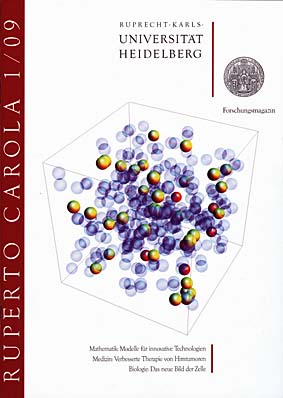Ruperto Carola 1/09: A New Era in Image Processing
18 05 2009

| |
|
|
In his title piece in the most recent issue of the Heidelberg Research Magazine Ruperto Carola, Christoph Schnörr proclaims a new age of signal and image processing. The article discusses the basic question of mathematical models that have immediate industrial applications. Schnörr, who has been at the university since 2008, conducts his research at the Heidelberg Collaboratory for Image Processing, a new partnership between research institutions and private industry established as part of the Excellence Initiative.
Religious studies scholars at Heidelberg University, exploring the role that Zen Buddhism plays in contemporary Japan, go beyond studying texts. Going into the field, they speak with religious agents, observe their actions, and even participate in temple ceremonies. As the studies discovered, Zen Buddhist schools are extraordinarly prevalent in modern Japan. As Inken Prohl, a professor at the Institute for Religious Studies at Heidelberg University since 2006, reports, however, Japanese Zen Buddhism bears very little resemblance to European conceptions of Zen Buddhism.
To this point, it has only been possible to prepare cells and tissues for closer inspection by badly mishandling them. The chemical methods used to fix the samples so that they could be examined in vacuum conditions under an electron microscope killed the tissues. In his article, Rasmus R. Schröder explains a new process that allows cell and tissue samples to be rapidly frozen without destructive ice crystals forming. The fragile biological structures are thus preserved unchanged. These vitrified samples are essentially snapshots of the living cells, and can be observed using modern cryomicroscopes, allowing us to better understand the realities of life. Rasmus R. Schröder joined the Excellence Cluster “Cell Networks” in 2008.
Heidelberg University’s cluster “Asia and Europe in a Global Context” was successful in the German Research Foundation’s Excellence Initiative competition. The co-director of this project, Rudolf G. Wagner, clarifies the challenges facing the cluster in his article. The established structures of the humanities and the social sciences, according to Wagner, a Sinologist, grew up out of the structural thinking dominant in the 19th century. This structural thinking reified the scientific findings, career paths, publications, professional networks and programs of study in the 19th century. “Whomever tries to change this, does so at their own risk.”
In the 1960s, fewer than five percent of children with cancer survived. Now, more than 80 percent survive. This success was made possible by research in molecular biology, which traces the development of tumours at the cellular, molecular and genetic levels. The results of this research include, for example, the discovery of molecular markers that predict the intensity of leukaemia treatment necessary to achieve the highest possible remission rate. These markers were also identified in cases of childhood brain tumours, and allow us to hope for individual, targeted therapies, according to the article contributed by Stephan Pfister, recipient of Heidelberg University’s Dr. Hella-Bühler Prize.
“Illness as a Sin? A Historical Reflection” is the title of Annette Wiessenrieder and Gregor Etzelmueller’s essay. Following this article, Paul Kirchhof introduces the 2008 winners of the Ruprecht Karls Prize, the Fritz Grunebaum Prize, and the Viktor and Sigrid Dulger Foundation’s Environmental Research Prize.
The Heidelberg Research Magazine is published by Universitätsverlag Winter, Heidelberg. Each issue costs 5 euros plus shipping. A supporter’s subscription can be purchased for 30 euros from: Universität Heidelberg, Communications und Marketing, Press Office, Postfach 10 57 60, 69047 Heidelberg. Free sample copies of older issues can be found in the foyer of the university’s Old Aula. Further information and full-text copies of older issues can be accessed online at:
http://www.uni-heidelberg.de/presse/publikat.html
Further information:
Heidelberg University
Communication and Marketing
Dr. Michael Schwarz
Press Officer
michael.schwarz@rektorat.uni-heidelberg.de
Irene Thewalt
phone: +49 6221 542310
fax: +49 6221 542317
presse@rektorat.uni-heidelberg.de

